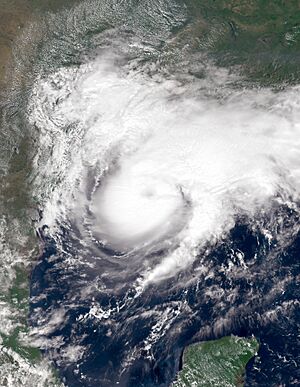Hurricane Francine (2024) facts for kids

Francine near peak intensity while approaching Louisiana on September 11
|
|
| Meteorological history | |
|---|---|
| Formed | September 9, 2024 |
| Category 2 tropical cyclone | |
| 1-minute sustained (SSHWS/NWS) | |
| Highest winds | 100 mph (155 km/h) |
| Lowest pressure | 972 mbar (hPa); 28.70 inHg |
| Overall effects | |
| Damage | Unknown |
| Areas affected | Eastern Mexico, Gulf Coast of the United States (particularly Texas and Louisiana) |
|
Part of the 2024 Atlantic hurricane season |
|
Hurricane Francine was a strong storm that hit Louisiana in September 2024. It was the sixth named storm and fourth hurricane of the 2024 Atlantic hurricane season. Francine formed after a quiet time for storms in the Atlantic Ocean.
The storm started as a tropical wave in the central Atlantic. This wave was first noticed by the National Hurricane Center (NHC) in late August. It slowly got stronger as it moved. By September 7, it was near the Yucatan Peninsula and entered the Bay of Campeche.
Contents
How Hurricane Francine Formed
On August 26, weather experts at the NHC saw a chance for a low-pressure area to form. This is like a swirling area of air that can become a storm. Two days later, they started watching a tropical wave. This wave brought some rain, but it was not very organized at first.
The weather conditions were not good for the wave to grow stronger. So, it stayed disorganized for a few days. But on September 7, the wave moved into the Bay of Campeche. The next day, it became a low-pressure area.
A few hours later, on September 8, it was named Potential Tropical Cyclone Six. This means it had the chance to become a tropical storm. The next day, it got stronger and became Tropical Storm Francine.
The new storm moved slowly northwest at first. It was close to the Mexico–United States border. Then, a high-pressure system over Florida pushed it northeast. Francine kept getting stronger. It became a hurricane on September 11.
Francine's Journey and Landfall
As Francine moved northeast, it sped up towards the Gulf Coast of the United States. An eyewall began to form. This is a strong ring of thunderstorms around the center of a hurricane. Even with some difficult weather conditions, a clear eye formed in the middle of the storm.
Francine reached its strongest point as a Category 2 hurricane. Its winds were about 100 miles per hour (155 km/h). This happened on September 11. Soon after, Francine hit land in Terrebonne Parish, Louisiana. This is called landfall.
After hitting land, the hurricane quickly lost strength. By September 12, Francine had weakened back into a tropical storm.
Preparing for Hurricane Francine
Mexico's Preparations
People in parts of Mexico got ready for the storm. Tropical storm watches were put in place for areas like Barra del Tordo. Other parts of Northeast Mexico were under a tropical storm warning. This means tropical storm conditions were expected.
In Tamaulipas, schools in cities like Matamoros were closed. This helped keep students safe.
United States' Preparations
Companies like ExxonMobil and Shell stopped their work in the Gulf of Mexico. They moved their workers to safety. Amtrak, a train service, also stopped its trains to New Orleans for several days.
Texas Gets Ready
South Texas was under a tropical storm warning. Galveston County raised its emergency alert level. This meant they were getting very serious about storm preparations.
Governor Greg Abbott sent out water rescue teams. These teams were ready to help people if there was flooding.
Louisiana's Preparations
Hurricane warnings were issued for many parts of Louisiana. This included areas from Sabine Pass to Morgan City. The governor declared a state of emergency. This allowed the state to use special resources to prepare.
The governor also sent 2,300 members of the Louisiana National Guard. They went to areas that might be hit by the storm. Many school districts in Louisiana closed. This was to keep students safe.
Some areas had mandatory evacuations. This meant people had to leave their homes. These places included Grand Isle and Lafitte. Some parishes, like Lafourche, had curfews. This meant people had to stay inside after a certain time.
Many parishes raised their floodgates. These are barriers that help stop water from flooding. Cities like Baton Rouge gave out sandbags. These help protect homes from floodwaters.
Louis Armstrong International Airport canceled all flights. Several USPS locations also closed. Important oil ports like Port Fourchon were shut down.
Other States Prepare
The coasts of Mississippi and Alabama were also under tropical storm warnings. The Governor of Mississippi declared a state of emergency. A shelter was set up in Jackson, Mississippi. Some schools in Mississippi also closed.
What Happened During Francine
Mexico's Impact
Some areas in Matamoros, Mexico, had flooding. This was due to about 8 inches (200 mm) of rain. The Mexican Government was asked for help. Water pumps were used to remove water from the city.
United States' Impact
Francine caused problems for exports from the Gulf of Mexico.
Texas' Impact
By September 9, Port O'Connor in Texas was already seeing flooding.
Louisiana's Impact
Francine hit southern Louisiana with strong winds. It made landfall in Terrebonne Parish on September 11. A tornado warning was issued for Plaquemines Parish.
Over 200,000 homes in southeastern Louisiana lost power. Francine's strong winds knocked down many trees and power lines. This blocked roads and made travel difficult. Many streets also flooded because of the heavy rain.
After the Storm
Mexico's Aftermath
After the storm, special plans were started in Mexico. These plans, called DN-III and Tamaulipas, helped provide aid. They brought help to the areas affected by Francine.
See also
- Other storms of the same name
- Weather of 2024
- Tropical cyclones in 2024
- List of Category 2 Atlantic hurricanes
- List of Louisiana hurricanes (2000–present)

